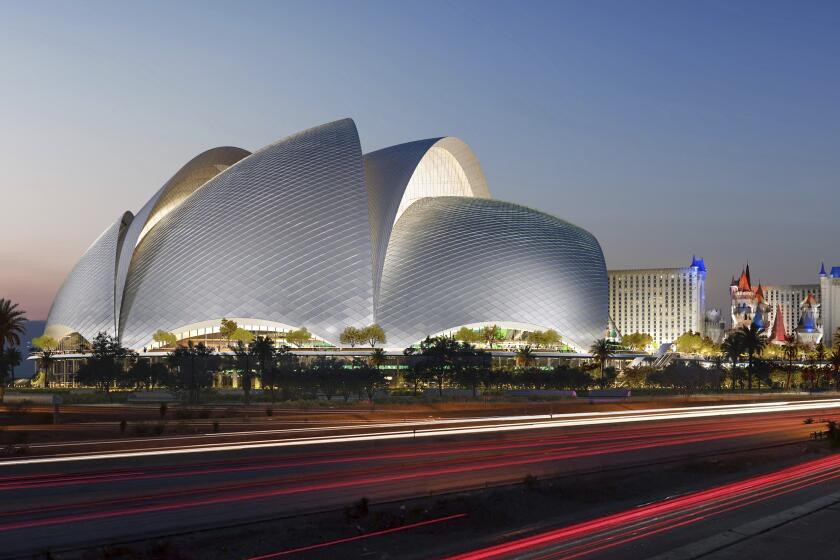Baseball teams are abandoning cities across California. How some are fighting back
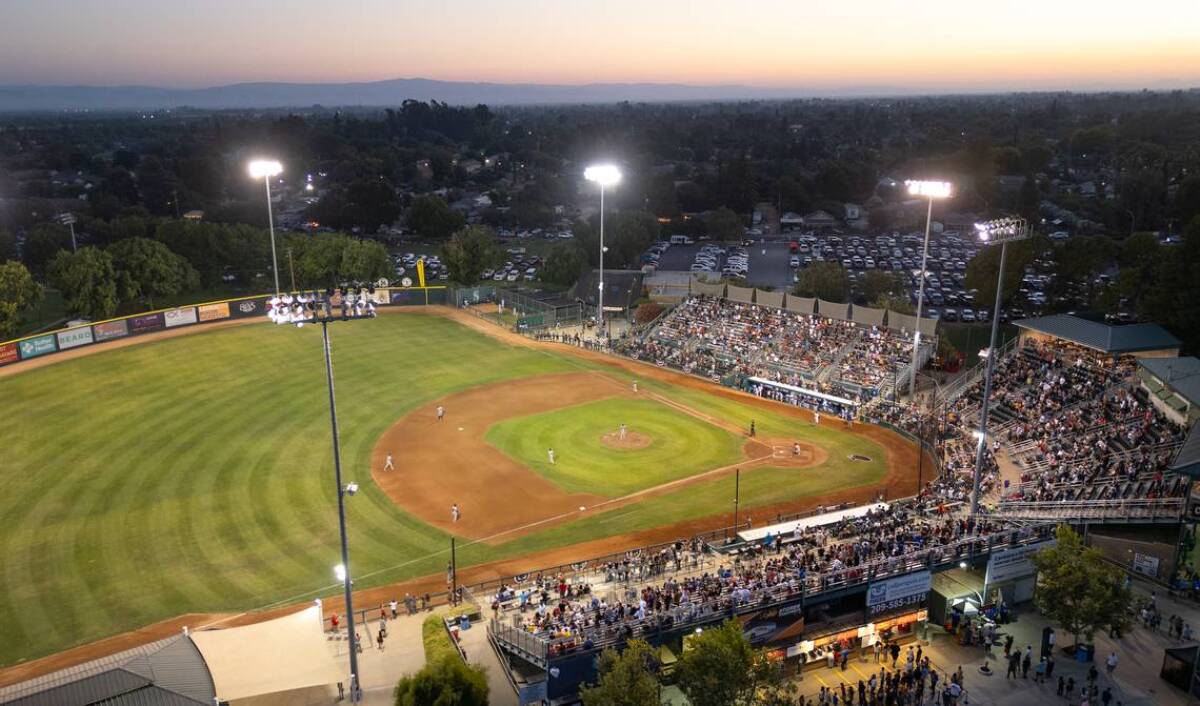
- Share via
- California’s reputation for being a minor league baseball hot spot is threatened by a number of factors.
- There is growing pressure on minor league teams to have state-of-the-art facilities, and Ontario is hoping to lure a team.
- The Oakland Ballers are satisfying the need for baseball in Oakland with the Athletics’ imminent departure.
The historical marker stands proudly on 10th Street, a few steps from Modesto City Hall. The marker celebrates the beloved movie “American Graffiti,” a tribute from filmmaker George Lucas to the car cruising culture of his hometown, set in 1962.
By then, Modesto had hosted a team in baseball’s California League for 16 years. The historic California League has endured. Modesto’s team might not.
“There is such a long history of baseball in Modesto,” Mayor Sue Zwahlen said. “I remember my grandfather talking about going to the games.”
No other American sport binds generations like baseball. Yet, at a time efforts to grow the game by developing a younger and more diverse fan base finally are paying off, baseball teams are abandoning minor league and major league markets in the nation’s most populous state.
Three teams in the California League — in Bakersfield, Lancaster and Adelanto — shut down in the last seven years. In the majors, the Athletics play their final game in Oakland on Sept. 26. The A’s, bound for Las Vegas after a pit stop in Sacramento, will become the first major league team in 20 years to ditch their fan base and start anew somewhere else.
Modesto could be the next team on the move.
In 1966, the Modesto roster featured three future Hall of Famers: outfielder Reggie Jackson, pitcher Rollie Fingers, and infielder and eventual manager Tony La Russa. The best player that year, however: a catcher named Dave Duncan, who hit 46 home runs. As it turned out, Duncan made his name in baseball as one of the sharpest pitching coaches in history, primarily working with La Russa.
The chance to see rising stars helps fuel the popularity of the minor leagues. So do cozy ballparks and affordable tickets. In Modesto, John Thurman Field offers a bounce house for young fans, a beer garden for the young at heart and an “intentional walk” program that affords fans the chance to throw out the first pitch if they get in enough steps walking around the ballpark.
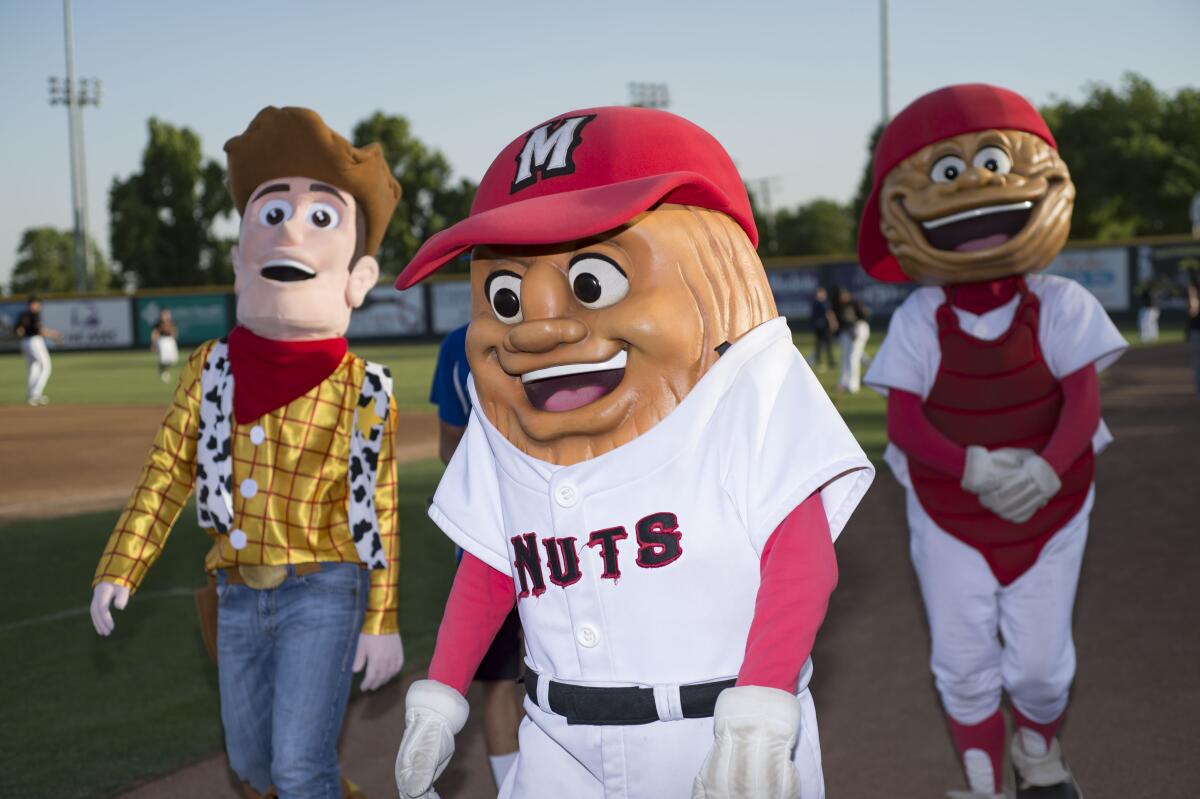
The team is called the Nuts, an homage to the Central Valley, where almost all almonds, walnuts and pistachios in the United States are grown. The team’s mascots: Al the Almond, Wally the Walnut and Shelley the Pistachio.
In 2024, cozy ballparks and cute mascots are no longer enough. Major League Baseball wants its prospects playing in first-class stadiums with modern amenities. The choice for Modesto: pay $32 million for upgrades — among them larger clubhouses, expanded training facilities, separate dining areas and a women’s dressing space — or risk losing the team.
Modesto’s 2025 season will be its 79th in the California League, and could be its last. That, the locals might be forgiven for saying, is nuts.
Alan Wapner hardly could contain his excitement. For almost three decades, the Ontario city councilman has pursued a minor league baseball team for his city. Now Ontario is on the verge of landing one — and not just any minor league team, but one affiliated with the Dodgers.
The scoreboards in Ontario, he said, are planned as hexagons — just like the ones at Dodger Stadium.
“We’re half-jokingly talking about a Union 76 ball out there,” Wapner said.
The Dodgers’ entry in the California League — now the Rancho Cucamonga Quakes — agreed to move into the new Ontario ballpark, scheduled to open in 2026, city officials said.
Quakes owner Bobby Brett declined to comment, but city documents say the team “intends to relocate its operations to the city of Ontario.” Jennifer McLain Hiramoto, the city’s director of economic development, said Ontario would pay about $100 million to build the ballpark.
“The way I describe it,” Wapner said, “it’s a major league stadium hosting a minor league team.”
The former baseball stadium that hosted the Lancaster JetHawks is poised to host a USL-affiliated pro team that could help revitalize the high desert.
Most independent economists would scoff at that level of taxpayer investment, in part because the local audience for minor league baseball already is served by another California League stadium eight miles from the proposed Ontario ballpark, and in part because entertainment spending within the city would be diverted from, say, the mall or the sports arena to the ballpark.
Hiramoto declined to provide a copy of the city’s economic impact report, but said Ontario would build not only a ballpark but also an entirely new audience for it.
For one, she said, the ballpark would sit within a development already planned to include 50,000 new homes, which would double the city’s population from close to 200,000 to close to 400,000.
“Essentially, we’re building out an entirely new city,” she said.
The development also is planned to include a 200-acre sports complex for what Hiramoto called “youth tourism,” with facilities for travel teams in baseball, softball, soccer, basketball, football, tennis and swimming.
“We’re looking at creating the center of the universe for sports within the Inland Empire and beyond,” she said.
This has been something of an open secret within the California League: The Dodgers’ affiliate would move from Rancho Cucamonga to Ontario, the Angels’ affiliate would move from San Bernardino to Rancho Cucamonga, and the Seattle Mariners’ affiliate would move from Modesto to San Bernardino.
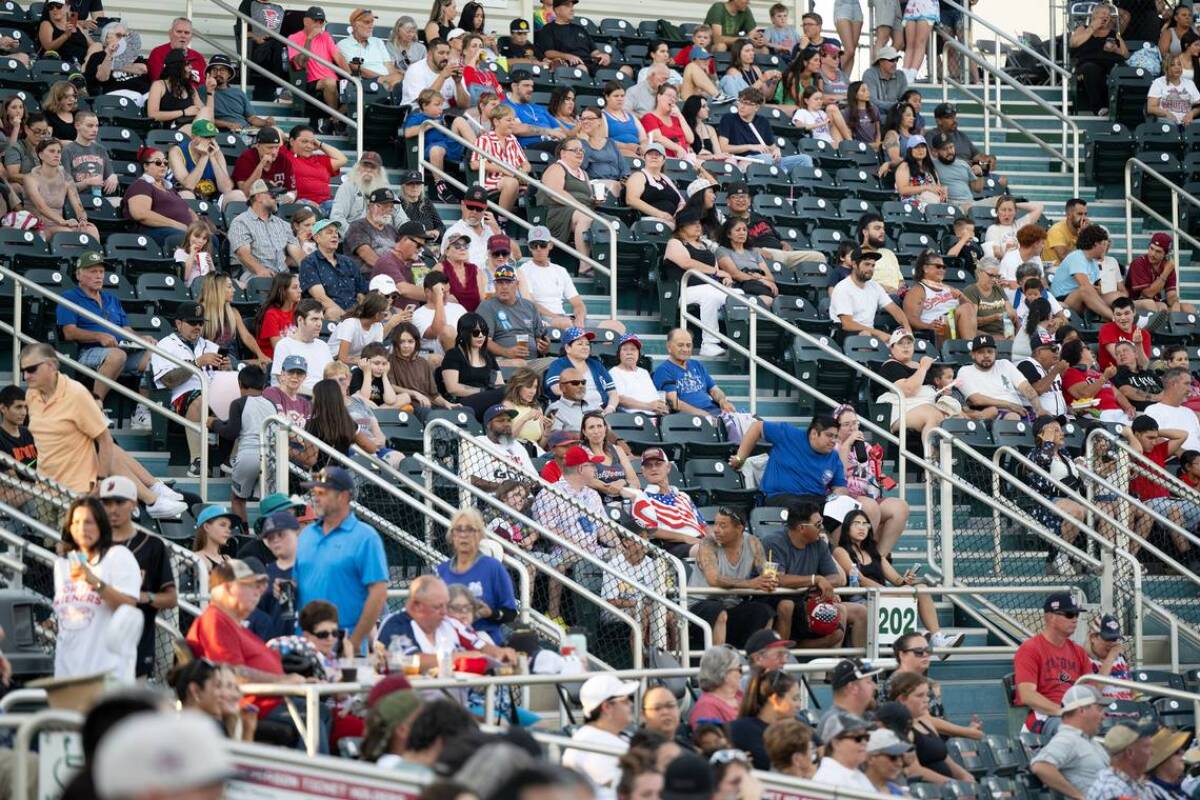
But all of that appears contingent on Modesto losing its team, and the city last month agreed to a lease extension with the Nuts through the 2025 season. Under the extension, the city and the Nuts have until April 1 to reach the long-term deal both sides say they want.
“We just have to get into uncomfortable conversations to see what the next steps are to be able to stay,” Nuts general manager Veronica Hernandez said.
At first glance, Modesto could get an unbelievable deal. While Ontario would put up $100 million for its proposed ballpark, Hernandez said the Mariners, the owners of the Nuts, would put up all of the $32 million necessary for the MLB-mandated improvements at the Modesto ballpark. The city would pay nothing.
In a baseball world where “public-private partnerships” are the preferred buzzwords, the Mariners’ offer was so generous that multiple officials in the commissioner’s office were startled to hear about it.
Joe Lopez, the city manager in Modesto, acknowledged the offer but said any deal would extend beyond simply paying for renovations. He declined to go into detail, but issues like these could come up: Would the Mariners ask that rent be waived in exchange? (That is the deal the Angels made with Anaheim three decades ago, when they agreed to pay $97 million for stadium renovations.) And what happens if someplace like Ontario dangles a shiny new palace in front of the Nuts in another decade or so?
“The city has a long history of subsidizing the team,” Lopez said. “We’re still having to pay for improvements that were done 20 or 30 years ago.”

With an aging stadium surrounded by a golf course and soccer fields, could the city redevelop some or all of that land and generate more revenue for police, fire, road and sidewalk services? Could minor league soccer be a better economic bet than minor league baseball? Or could the Nuts and the city work together to bring more events to the ballpark on days without a game?
“The baseball things, the Mariners have mentioned they would take care of,” Hernandez said, “but what can we do for our community here at the stadium to better support the community?”
Within baseball, a long-term deal in Modesto is considered a long shot. However, if a deal is reached, the commissioner’s office would have three teams for four cities: three that would have agreed to MLB demands so existing ballparks could meet the new facility standards, and a fourth committed to spending $100 million on a new ballpark. Could Ontario improbably end up as the odd city out?
The A’s arrived in Oakland in 1968. Their inaugural roster included five members of that 1966 Modesto team: Jackson, Fingers, La Russa, Duncan and outfielder Joe Rudi.
In Oakland, the A’s won four World Series championships, more than any other California team during their tenure. The A’s won with distinction and flair: “Bash Brothers” Mark McGwire and Jose Canseco; white cleats and kelly green jerseys; Rickey Henderson’s unmatched combination of power, speed and swagger; drummers in the bleachers; Dave Stewart staring down and then beating Roger Clemens, repeatedly.
Seven months ago, as the A’s embarked on their final season in Oakland, commissioner Rob Manfred said MLB would continue to support youth clinics and community programs in the East Bay. He also said fans there need not turn their backs on MLB.
“First of all, we do have a major league team in the Bay Area,” Manfred said then. “It’s not like there is not an available option. The Giants obviously still play there.”
The Giants? Root for the rival team? The team that refused to yield its territorial rights so the A’s could stay in the Bay Area and move to San José?
The Savannah Bananas have thrown out every boring baseball rule, attracting thousands of fans. This is why Banana Ball has MLB’s attention.
That did not sit well with Oakland fans, and in particular two fans with the ability to do something about it.
The Golden State Warriors left Oakland in 2019. The Raiders did the same in 2020. Just this year, even before the A’s started their final season in Oakland, the In-N-Out and Denny’s restaurants around the Coliseum closed their doors.
Paul Freedman and Bryan Carmel grew up going to A’s games. Freedman is an entrepreneur who still lives in Oakland. Carmel is a producer and writer who lives in Los Angeles. They dreamed up the Oakland Ballers, an independent minor league team that would play in a deteriorating public park in oft-neglected West Oakland.
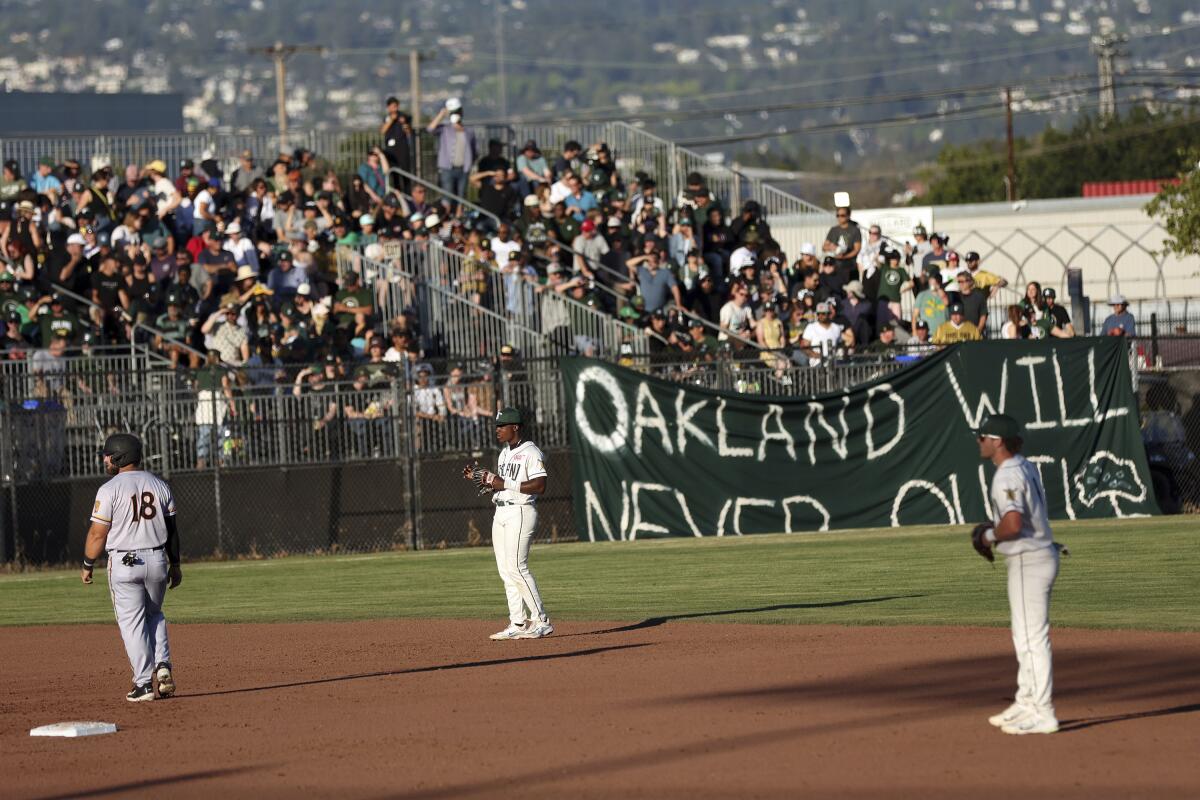
“At a moment Oakland was looking to lose its pro sports, and at a moment where the city has been teetering through a lot of challenges, it just felt like it was a bridge too far not to have baseball here,” Carmel said.
In five weeks, a pop-up ballpark came to life. Carmel basically moved back to the Bay Area: into his parents’ house and, at 46, into his childhood bedroom. His father sometimes dropped him off at the park.
In the final stretch of construction, fans and neighbors stopped by to help. On the day before the opener, Carmel picked up furniture for the visiting dugout from Ikea, and 20 volunteers helped assemble it.
“I love Oakland, and I love baseball,” Ballers fan Carolyn Jones said. “This is what we’ve got, and we’re lucky to have it.
“It’s a risk. It’s a huge risk. All these other businessmen have said they can’t make it in Oakland, but these guys have said, ‘Yes, we’re going to give it a shot.’ That is not a minor thing.”
A neighborhood is coming to life too, with condos across the street from the ballpark, and a farmers market within walking distance, and valet parking if you bike to the ballgame and public transit if you do not. The A’s fan clubs already have migrated from the Coliseum, along with the outfield drummers and the chants of “Let’s go, Oak-land!”
“You’re getting the amenities, with the cheers and activities between innings, without a lot of the hassle, and without the attitude that the A’s were bringing,” former Oakland school board president Jody London told me at a recent Ballers game.
“This is kind of a love fest for Oakland.”
To underscore the Ballers’ raison d’etre — a baseball team that never would abandon Oakland — Freedman and Carmel sold ownership stakes to fans. If the Ballers ever considered leaving town, fans would have a say — not veto power, but one collective vote among five on the board of directors.
Almost anyone could buy one of those stakes, but the fine print could be appreciated with a wink and a nod: If you were affiliated in any way with the owners of the A’s, you would not be allowed to buy.
In Bakersfield, professional baseball remains, but only in the form of the Pecos League, a bare-bones independent league that averaged 324 fans per game last year, according to the annual Number Tamer attendance analysis.
In Adelanto, the ballpark is now an event venue. In Lancaster — and at the Oakland Coliseum — the ballpark will be used for minor league soccer games next year.
In the minor league cycle of life, this is not unusual. California League cities that have lost teams over the decades include Palm Springs, Riverside, Salinas, Santa Barbara, Ventura and Lodi.
In 2021, however, MLB took over the minor leagues, cutting 43 teams affiliated with major league organizations and mandating the remaining 120 commit to an industry standard for their ballparks, often at significant expense to the host cities. (Lancaster lost its team at that time; Bakersfield and Adelanto had lost teams in 2017.)
“We are making every effort possible to keep affiliated baseball in the communities that have historically had it,” said Morgan Sword, MLB executive vice president of baseball operations.
“The trick here is that the quality of the facilities that affiliated professional baseball players need to play in in 2024 is significantly elevated relative to what it was 30 years ago. That form of baseball is not a perfect fit for every community. That’s OK. But there are other forms of baseball that don’t require that level of facilities, and we have tried to find a fit where we can.”
What the best fit might be for Modesto remains in question.
“It’s heartbreaking for the Nuts,” said Freedman, the co-founder of the Ballers.
“Most people went to baseball games with their grandfather,” Freedman said. “You didn’t go to a soccer game. I didn’t go to a soccer game with my grandpa. Baseball has that nostalgia, and I think it’s heartbreaking for any community to lose that.”
Said Carmel, the Ballers’ other co-founder: “We want to be a place where you can come and run into your kid’s second-grade teacher, or the crossing guard. With a lot of things in our country, that sense of community is being brushed aside, because we are just driven by corporate interests. If you can start there and build off that, there is no limit to how far it can go.”

Of the 43 cities left behind in the minor league restructuring, the commissioner’s office helped arrange some form of baseball for 41 — some in the Pioneer League, the independent league the Ballers joined.
In affiliated leagues, major league teams find and pay players; in independent leagues, teams do that. For the most part, independent league players hope to play well enough that a major league team buys out their contract and sends them to an affiliated team.
The city of Oakland is not subsidizing the Ballers. Neither is MLB. In order to admit the Ballers, the Pioneer League insisted they launch and fund another team in Davis and subsidize the travel costs of six teams based in Colorado, Idaho, Montana and Utah.
Freedman, who calls himself a “startup guy,” is in for $5 million, according to the team’s investment offering. He has no assurance he will make any of that money back, let alone earn a return on his investment. The $1.2 million the Ballers raised by selling ownership stakes to fans went to cover operating costs, according to the offering, not to Freedman. If the Ballers turn out to be a novelty, he loses.
He has a plan, of course: Sell the Davis team to local investors and start up a West Coast division of the Pioneer League.
“I think Long Beach should have a Pioneer League team,” Freedman said. “Long Beach has its own unique identity. If I’m from Long Beach, I don’t want to be told I have to be a Dodger or Angel fan.”
A Nevada teachers union loses another legal challenge aimed at blocking the potential use of public funds for a baseball stadium in Las Vegas for the A’s.
The owners would not be corporate types who could bid one town against another. The owners would be community members and/or the communities themselves, anchoring teams where they play.
“I think that has worked here in Oakland,” Carmel said. “Is that replicable in Bakersfield, Modesto, and so on? I want to think it is.”
Sword, the MLB executive, said he hopes to catch a Ballers game in person next year.
“I hope that they can be successful,” he said. “It’s a very cool story. We’ve been keeping an eye on it for sure.”
At the Ballers’ games, a good crowd is 3,000 and not 30,000. The Ballers players dress in the corner of a warehouse across the street. The visiting players dress in the converted bathroom of a public park.
In the hour before a recent game, Freedman and I were chatting next to a ketchup dispenser. A middle-aged woman thought she recognized Freedman and politely interrupted us.
“Are you Paul?” she asked.
“Yes,” Freedman said.
“Thank you,” she said, then headed toward the bleachers.
More to Read
Go beyond the scoreboard
Get the latest on L.A.'s teams in the daily Sports Report newsletter.
You may occasionally receive promotional content from the Los Angeles Times.



